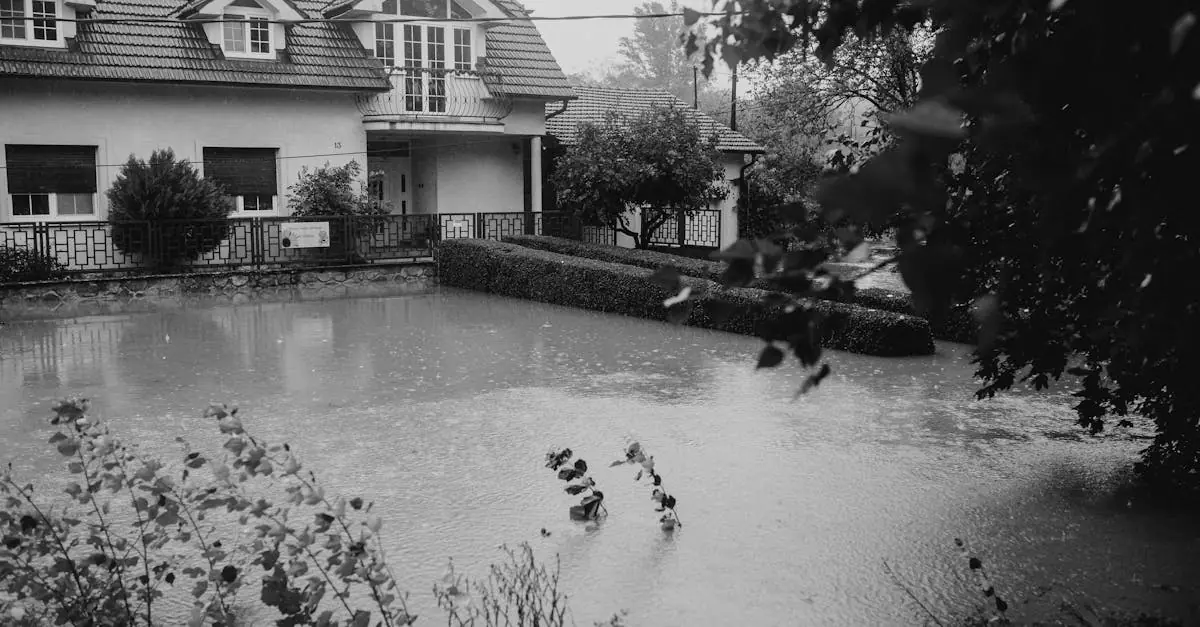Table of Contents
ToggleWhen a neighbor’s tree takes a tumble and crashes onto their property, it can feel like a scene from a slapstick comedy—except the punchline is your wallet. Homeowners often wonder if their insurance will swoop in like a superhero to save the day. The truth is, the answer might not be as straightforward as one would hope.
Navigating the world of homeowners insurance can be as tricky as a squirrel on a tightrope. It’s essential to understand what’s covered and what’s not when it comes to those leafy giants in our yards. So, before you start pointing fingers or plotting your next move, let’s dive into the ins and outs of tree damage and insurance coverage. After all, a little knowledge can keep both your finances and your neighborly relations intact.
Overview of Homeowners Insurance
Homeowners insurance provides financial protection for residential properties against various risks. Policies typically cover damages to the home, personal belongings, liability for injuries on the property, and additional living expenses if the home becomes uninhabitable. Understanding these coverages is crucial for homeowners.
Coverage for trees varies by policy. Tree damage, whether caused by storms, insects, or diseases, generally falls under dwelling or personal property coverage. Additionally, liability coverage might protect homeowners from claims if a tree on their property damages a neighbor’s property.
Certain exclusions exist in homeowners insurance policies. For example, damage from neglect or lack of maintenance often isn’t covered. Homeowners must review their specific policy details, as coverage limits and deductible amounts can impact claims.
Situations involving fallen trees can complicate matters further. If a homeowner’s tree damages a neighbor’s property, liability coverage may apply if negligence is proven. Conversely, strict liability laws in some states might place liability solely on the property owner where the tree stands.
Communicating with the insurance provider ensures clarity. Homeowners should ask about specific tree-related coverage and any associated exclusions. Reviewing homeowners insurance annually is advisable to ensure appropriate coverage levels for unexpected events.
Understanding Tree Damage Liability
Tree damage liability involves knowing who is responsible for damage caused by trees, especially when they fall onto neighboring properties. Homeowners should understand the types of damage and their legal obligations.
Types of Tree Damage
Damage caused by trees can vary significantly. Fallen branches or entire trees can result in property damage, injury, or both. It’s vital to categorize the damage based on the source. One type involves storm-related incidents where wind or rain causes trees to fall. Another includes maintenance-related issues, such as neglecting to trim overgrown branches. Uneven or weakened roots can pose risks as well, especially during severe weather. Each type of damage has different implications for homeowners and may be treated differently by insurance policies.
Legal Responsibilities of Homeowners
Homeowners bear legal responsibilities regarding tree maintenance and potential damage. If a tree poses a hazard due to poor upkeep, liability may arise when it damages neighboring property. Negligence plays a crucial role in determining responsibility. Homeowners must ensure trees are properly maintained. Local laws may also dictate specific responsibilities, which vary by state. In some places, strict liability applies regardless of negligence. Communicating with neighbors about tree health can help prevent disputes. Homeowners should also consult with legal experts to understand their obligations fully.
Homeowners Insurance Coverage
Homeowners insurance offers essential financial protection, but coverage for tree damage can vary. Understanding specific provisions is key to managing risk.
Standard Policy Provisions
Most standard homeowners insurance policies include coverage for tree damage. Coverage typically falls under dwelling and personal property sections. Policies usually protect against damage from natural occurrences like storms. Liability protection may also apply when a tree from a person’s property causes damage to a neighbor’s property. It’s vital to read the policy closely to uncover any exclusions. Homeowners should note that neglect can lead to denied claims. Some policies might not cover trees that weren’t properly maintained or inspected regularly.
Specific Coverage for Tree Damage
Specific coverage for tree damage often depends on the type of incident causing the damage. Policies may cover tree removal costs if a tree falls and damages the home or other structures on the property. If it falls onto a neighbor’s property, the liability coverage could apply if the policyholder is deemed negligent. Typically, tree damage from storms or accidents is covered, while damage from decay or neglect may not be included. Some policies also offer limited payouts for fallen trees, necessitating a review of coverage limits. Homeowners should regularly reassess their policies to ensure they align with current risks.
Neighbor’s Property and Liability
Understanding liability in the context of tree damage to a neighbor’s property is crucial for homeowners. Damage can arise from various scenarios, particularly when trees fall or branches break.
When Trees Cause Damage
Tree damage commonly occurs during severe weather events, such as storms. High winds and heavy rain often lead to fallen branches or entire trees. Neglected trees pose additional risks; decay or disease weakens them, increasing the chance of damage. Property owners shoulder responsibility for maintaining the health of their trees. If a tree falls due to lack of maintenance, liability often shifts to the homeowner where the tree grows. Ultimately, local laws govern these situations, influencing who pays for repairs.
Potential Insurance Claims Process
Filing an insurance claim for tree damage starts with documenting the incident. Homeowners should take clear photos of both their property and the neighbor’s property. Next, contacting the insurance provider becomes essential to report the damage and start the claims process. Insurance representatives will likely ask for details about the incident. They may request documentation of tree maintenance, further influencing the outcome. Determining responsibility hinges on policy specifics and local regulations. Having a clear understanding of one’s insurance policy before a claim is beneficial, ensuring that homeowners are prepared for the process.
Understanding homeowners insurance coverage for tree damage is crucial for every property owner. While many policies offer protection against various risks including tree-related incidents, specifics can vary widely. Homeowners must be proactive in reviewing their policies to identify exclusions and ensure adequate coverage. Regular communication with neighbors about tree health can prevent disputes and foster good relationships. Staying informed about local laws and responsibilities regarding tree maintenance also plays a significant role in liability. Ultimately, this knowledge helps homeowners navigate the complexities of insurance claims and protects them from unexpected financial burdens.





